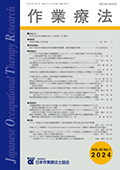Volume 43, Issue 1
Displaying 1-20 of 20 articles from this issue
- |<
- <
- 1
- >
- >|
FOREWORD
-
2024Volume 43Issue 1 Pages 1
Published: February 15, 2024
Released on J-STAGE: February 15, 2024
Download PDF (566K)
CONTRIBUTION
-
2024Volume 43Issue 1 Pages 3-5
Published: February 15, 2024
Released on J-STAGE: February 15, 2024
Download PDF (578K)
ORIGINAL ARTICLES
-
2024Volume 43Issue 1 Pages 6-14
Published: February 15, 2024
Released on J-STAGE: February 15, 2024
Download PDF (1058K) -
2024Volume 43Issue 1 Pages 15-22
Published: February 15, 2024
Released on J-STAGE: February 15, 2024
Download PDF (784K) -
2024Volume 43Issue 1 Pages 23-32
Published: February 15, 2024
Released on J-STAGE: February 15, 2024
Download PDF (1859K) -
2024Volume 43Issue 1 Pages 33-41
Published: February 15, 2024
Released on J-STAGE: February 15, 2024
Download PDF (1014K) -
2024Volume 43Issue 1 Pages 42-50
Published: February 15, 2024
Released on J-STAGE: February 15, 2024
Download PDF (758K) -
2024Volume 43Issue 1 Pages 51-60
Published: February 15, 2024
Released on J-STAGE: February 15, 2024
Download PDF (1014K) -
2024Volume 43Issue 1 Pages 61-69
Published: February 15, 2024
Released on J-STAGE: February 15, 2024
Download PDF (1017K) -
2024Volume 43Issue 1 Pages 70-77
Published: February 15, 2024
Released on J-STAGE: February 15, 2024
Download PDF (853K) -
2024Volume 43Issue 1 Pages 78-87
Published: February 15, 2024
Released on J-STAGE: February 15, 2024
Download PDF (1037K) -
2024Volume 43Issue 1 Pages 88-96
Published: February 15, 2024
Released on J-STAGE: February 15, 2024
Download PDF (1173K) -
2024Volume 43Issue 1 Pages 97-105
Published: February 15, 2024
Released on J-STAGE: February 15, 2024
Download PDF (1010K)
PRACTICAL REPORTS
-
2024Volume 43Issue 1 Pages 106-113
Published: February 15, 2024
Released on J-STAGE: February 15, 2024
Download PDF (989K) -
2024Volume 43Issue 1 Pages 114-120
Published: February 15, 2024
Released on J-STAGE: February 15, 2024
Download PDF (1690K) -
2024Volume 43Issue 1 Pages 121-128
Published: February 15, 2024
Released on J-STAGE: February 15, 2024
Download PDF (1308K)
SHORT REPORTS
-
2024Volume 43Issue 1 Pages 129-132
Published: February 15, 2024
Released on J-STAGE: February 15, 2024
Download PDF (618K) -
2024Volume 43Issue 1 Pages 133-136
Published: February 15, 2024
Released on J-STAGE: February 15, 2024
Download PDF (652K) -
2024Volume 43Issue 1 Pages 137-140
Published: February 15, 2024
Released on J-STAGE: February 15, 2024
Download PDF (880K) -
2024Volume 43Issue 1 Pages 141-146
Published: February 15, 2024
Released on J-STAGE: February 15, 2024
Download PDF (702K)
- |<
- <
- 1
- >
- >|
